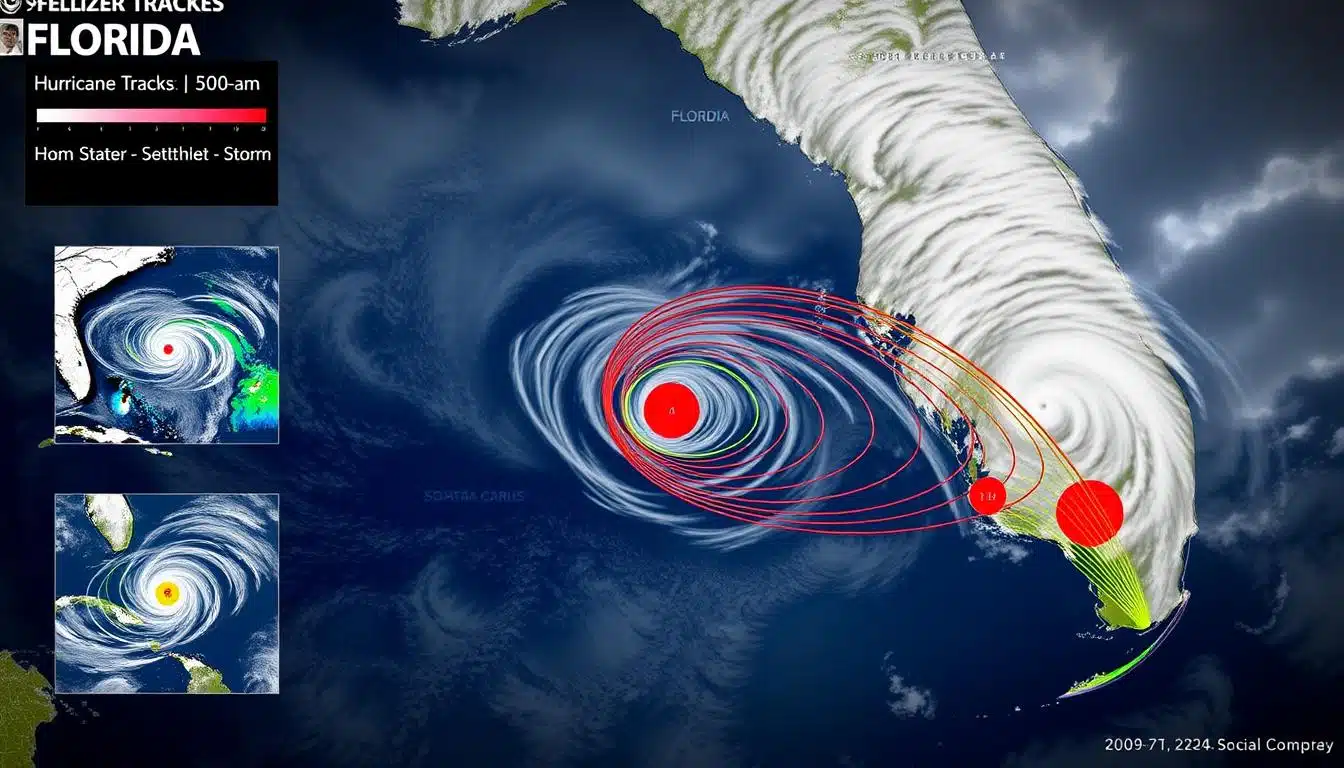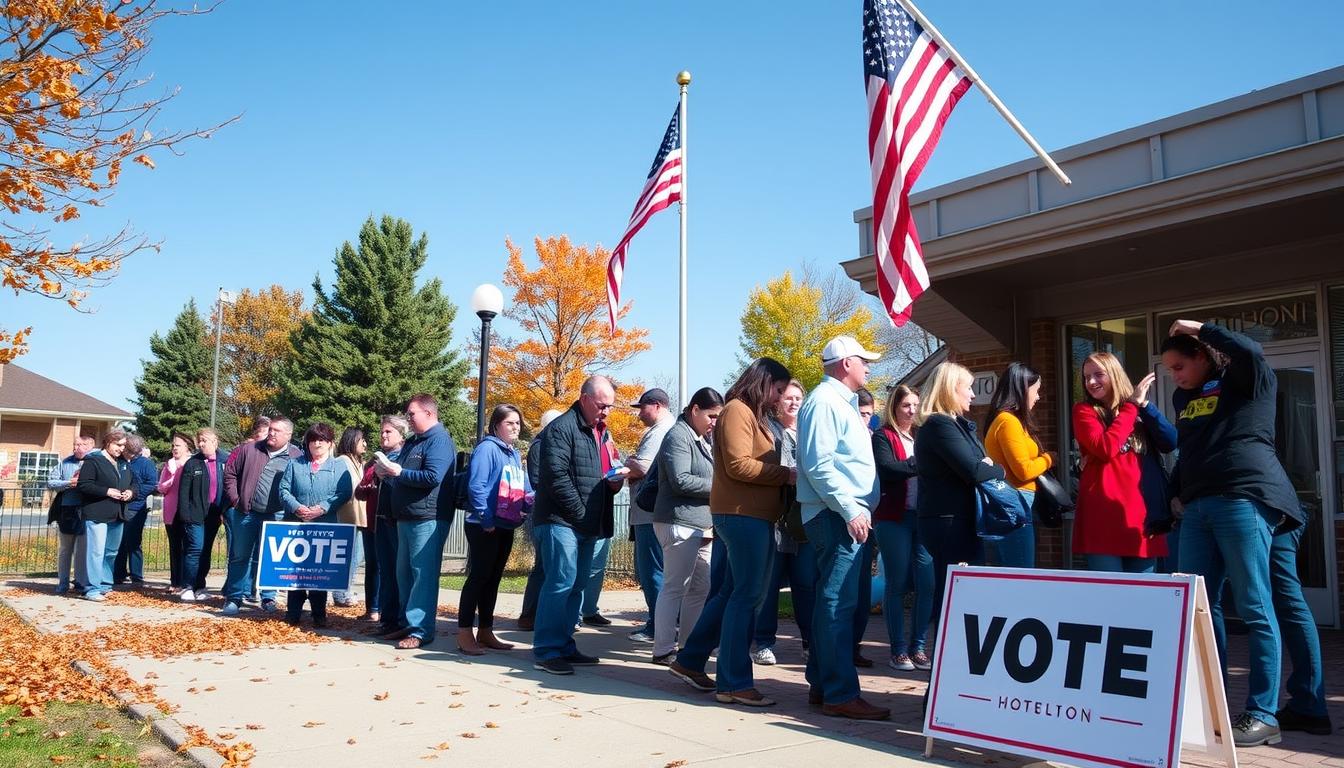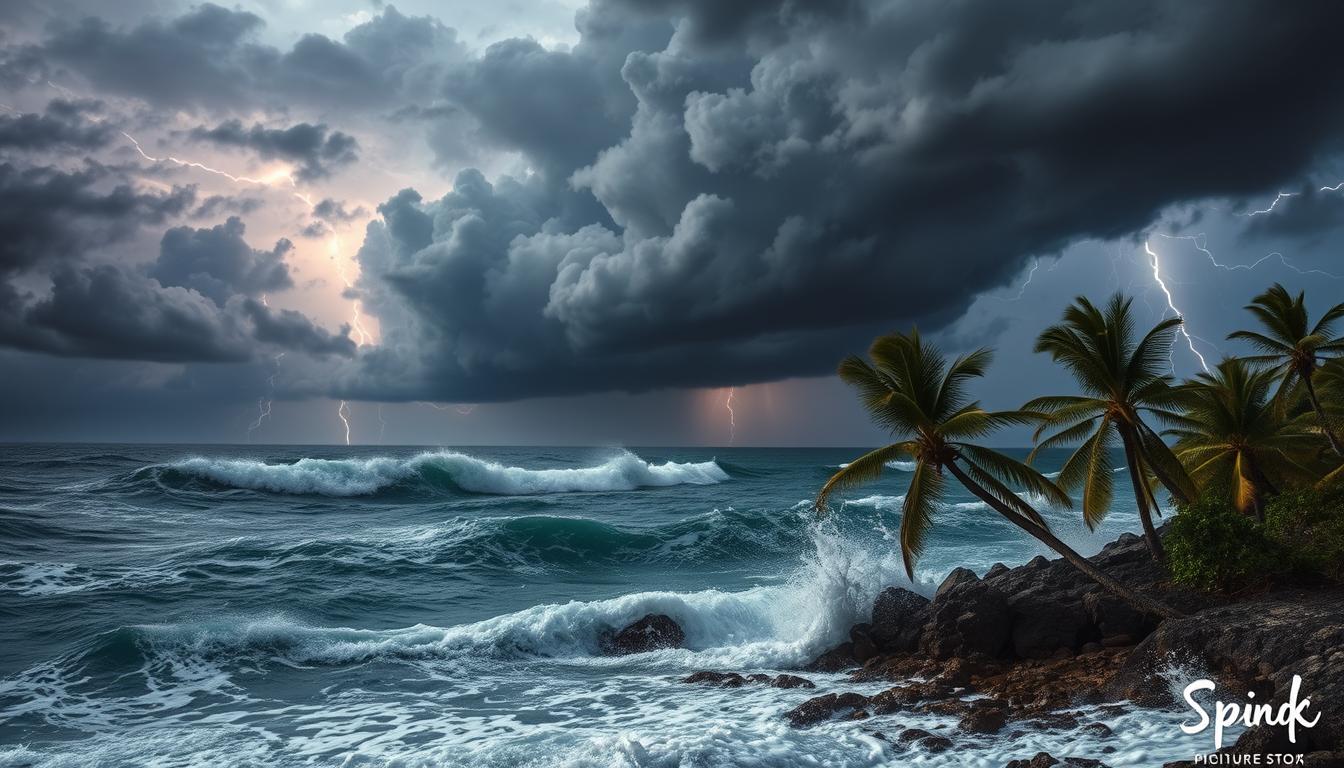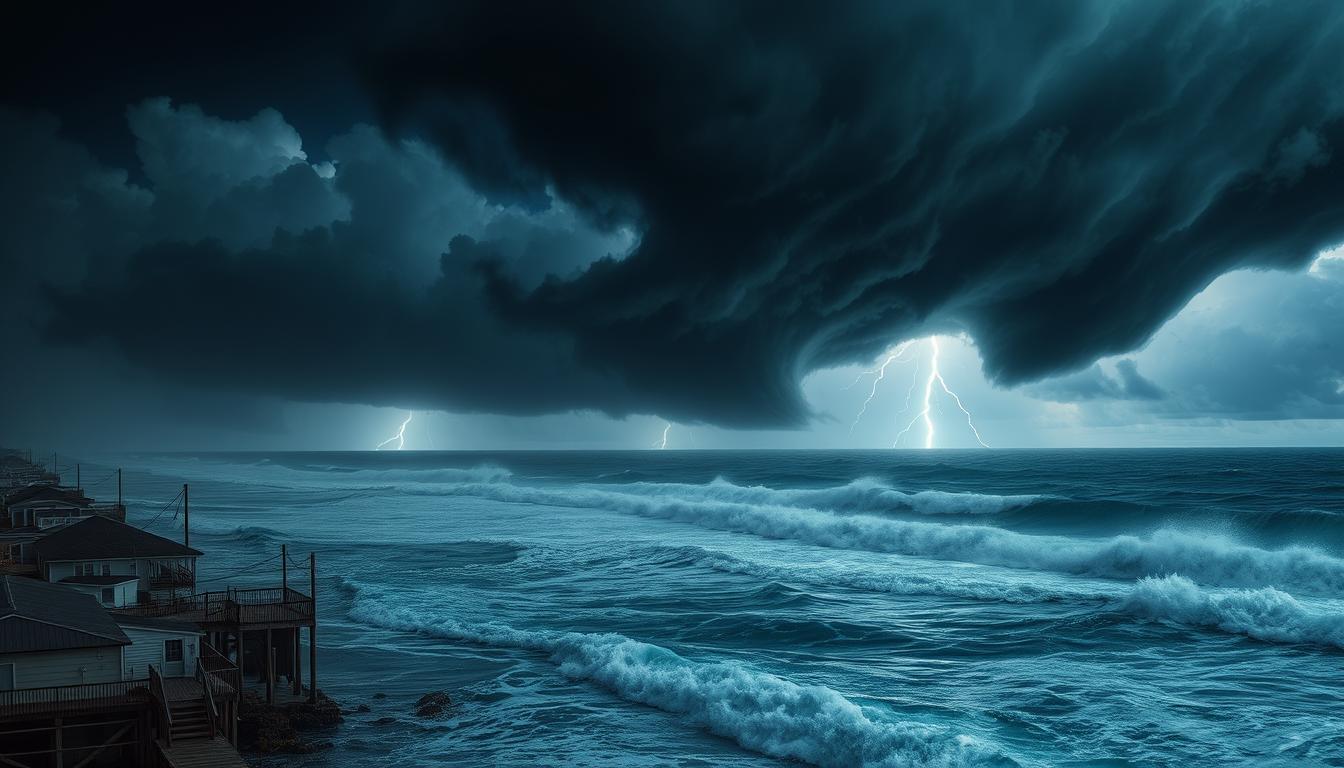As we prepare for Hurricane Helene, a powerful storm, a big question is: Are you ready for this historic hurricane?1
Experts say Helene could hit Florida’s Big Bend area hard. They predict winds of 130 mph and a storm surge of up to 20 feet12. With 61 of Florida’s 67 counties on emergency alert, it’s crucial to stay informed and act fast2.
Key Takeaways
- Hurricane Helene is expected to make landfall as a powerful Category 4 storm in Florida’s Big Bend region.
- Storm surge levels of up to 20 feet are predicted, creating a “nightmare scenario” for coastal communities.
- Over 60 of Florida’s 67 counties are under a state of emergency, urging residents in the storm’s path to evacuate.
- Helene is forecast to bring sustained winds of 130 mph with even higher gusts, leading to widespread power outages and damage.
- Stay informed, prepare your home, and follow all official evacuation orders to ensure your safety during this historic hurricane.
Preparing for Hurricane Helene’s Catastrophic Landfall
Hurricane Helene is heading straight for the Florida coast, and people are getting ready for the worst. The forecast says Helene will be a Category 4 hurricane with winds of 90 mph by landfall3. The storm surge could be as high as 20 feet in some places, especially in the Big Bend region and Tampa3. This will be the fourth hurricane to hit the US this year, and the fifth to hit Florida since 20223.
Storm Surge and Evacuation Warnings
Florida Governor Ron DeSantis has declared a state of emergency. Officials are telling people in Helene’s path to leave now. Senator Rick Scott says those in the storm surge area won’t make it, with up to 18 feet of water4. But, some people might not be able to leave because of evacuation challenges4.
Securing Homes and Gathering Supplies
People in the storm’s path are boarding up their homes and stockpiling supplies. Toho Water Authority is closing its lobbies on Thursday, September 26, to keep everyone safe. Schools along Florida’s Gulf Coast and in Georgia are closing too, readying for the storm3. Even after it hits land, Hurricane Helene will still be strong, causing power outages and damage in Georgia3.
| Impacted Areas | Evacuation Orders | Potential Storm Surge |
|---|---|---|
| Florida’s Gulf Coast | Mandatory evacuation orders in multiple counties | Up to 20 feet in some areas, with a significant threat of 20 feet in the Big Bend region and up to 8 feet in Tampa |
| Big Bend Region | Residents warned that they won’t survive the storm surge | Up to 18 feet |
| Tallahassee and Hernando County | Potential for up to 12 feet of flooding, triggering evacuations | Up to 12 feet |
As Hurricane Helene gets closer, Floridians and those in the Southeast must listen to all warnings. With a strong storm surge, high winds, and possible power outages, the next few days will be tough for everyone in the storm’s path.
Tracking Hurricane Helene’s Path and Intensity
Meteorologists are watching Hurricane Helene closely. They provide updates to keep everyone informed5. The storm has grown stronger, reaching Category 2 with winds of 100 mph5.
Experts predict it will get even stronger before hitting land. It could become a powerful Category 3 hurricane6.
Real-Time Updates from Meteorologists
As Hurricane Helene gets closer to Florida, meteorologists are warning everyone5. Tropical storm warnings are out for some eastern counties. Hurricane warnings stretch into Georgia, showing the storm’s power5.
A flood watch has been issued for East Alabama. They expect 4 to 6 inches of rain5.
The latest news says Helene will hit Florida’s Gulf Coast as a Category 4 storm6. Wind speeds could be over 130 mph6. The storm surge might reach 20 feet, threatening coastal areas6.
14 Florida counties have ordered evacuations. This includes Pinellas and Hillsborough, where people are getting ready6.
Helene has now become a Category 2 storm with winds of 100 mph7. It’s moving north-northeast through the Gulf of Mexico at 12 mph7. It’s expected to become a dangerous Category 3 hurricane before hitting Florida’s Big Bend area7.
A storm surge of 15 to 20 feet is forecasted for Apalachee Bay and parts of the northern Big Bend7.
| Location | Forecast Impact |
|---|---|
| Florida’s Gulf Coast | Catastrophic storm surge up to 20 feet, winds exceeding 130 mph |
| East Alabama | Potential for 4-6 inches of additional rainfall, flood watch issued |
| Georgia, Tennessee Valley, and Southern Appalachians | Significant flash and urban flooding |
As Hurricane Helene gets closer, it’s important for people in the area to stay updated. They should follow evacuation orders and prepare for safety. Meteorologists’ real-time updates are key to tracking the storm567.
hurricane tracker 2024 florida: Essential Apps and Resources
As Hurricane Helene heads towards Florida, it’s vital to stay informed and ready. Luckily, there are many apps and resources to help Floridians track the storm and stay safe8.
The Florida Division of Emergency Management’s app is a must-have for tracking hurricanes8. It gives updates on forecasts, evacuation orders, and where to find emergency shelters. This way, you always have the latest info9.
- The National Hurricane Center’s website and app offer detailed tracking maps, forecasts, and safety tips. They help you stay ahead of the storm9.
- Local weather apps from news stations and the National Weather Service give updates on your area’s conditions9.
- Emergency management websites like Ready.gov have guides on hurricane preparedness. They cover securing your home and making emergency kits8.
Don’t forget to use traditional media too. Local news will give you the latest updates and instructions from emergency management9.
By using these apps and resources, Floridians can stay informed and safe as Hurricane Helene gets closer9. Being prepared is key to weathering the storm and coming out strong8.
Staying Safe During and After the Storm
Hurricane Helene is quickly heading towards Florida’s coast. The safety of everyone living there is very important. It’s key for Floridians to listen to warnings and take steps to keep themselves and their families safe1.
Emergency Shelters and Evacuation Routes
Local officials have ordered people in coastal areas to leave. They tell residents to go to emergency shelters. But, getting to these shelters and finding the right evacuation routes can be hard for some, especially those with mobility issues or less resources2.
- Stay updated on evacuation orders and shelter locations through official channels.
- Plan your evacuation route early, considering traffic and road closures.
- If you can’t leave, find a safe, sturdy building to hide in. Avoid flooded or windy areas.
- Listen to local authorities and follow any curfew or movement rules during and after the storm.
Keeping in touch with local officials and watching reliable news for updates is key. This will help keep you safe during this tough time. By working together, we can get through this storm and come out stronger12.
Florida’s Response: State of Emergency Declared
As Hurricane Helene heads towards Florida, the state is getting ready for the disaster9. Governor Ron DeSantis has declared a state of emergency. This move brings in more resources and emergency teams to protect Floridians9.
The National Hurricane Center says Helene is a powerful Category 4 storm. It could get even stronger before hitting land9. The storm might bring winds of up to 135 mph and a storm surge of up to 20 feet in the Big Bend area9.
- All K-12 schools in Florida’s 67 counties are closed, as are 25 colleges and 11 state universities9.
- Airports are getting ready for the storm’s effects, expecting big disruptions to flights9.
Senator Rick Scott warns that storm surge areas might be too dangerous for survival9. Emergency teams are working hard to plan evacuations. Mandatory evacuations are in place for parts of 16 counties10.
| Metric | Value |
|---|---|
| Hurricane Helene’s Category | Category 210 |
| Sustained Winds | 100 mph10 |
| Expected Strength | Category 3 Major Hurricane10 |
| Projected Storm Surge | 20 feet in Big Bend, 8 feet in Tampa Bay, 5 feet in Charlotte Harbor10 |
Floridians are preparing for Hurricane Helene’s arrival. Emergency teams are working non-stop to keep everyone safe9. Declaring a state of emergency is key to getting the needed help for this disaster9.
Lessons Learned from Previous Hurricanes
As we prepare for Hurricane Helene, it’s important to remember Florida’s past battles with natural disasters11. The state has shown great resilience and preparedness, bouncing back stronger each time11.
Rebuilding and Recovery Efforts
After hurricanes, Florida has worked hard to rebuild and recover11. They’ve strengthened buildings, improved emergency plans, and helped communities11. This way, Florida is ready to quickly recover from Hurricane Helene11.
Florida has also learned to prepare better for hurricanes12. They’ve improved emergency plans and early warning systems12. This helps Floridians protect their homes and communities, lessening disaster impacts12.
Now, facing Hurricane Helene, we know Florida is more prepared than ever11. The state’s ability to adapt and innovate has grown11. Together, we’ll face this storm, ready to protect our state11.
Impact on Florida’s Infrastructure and Economy
Hurricane Helene, a powerful Category 3 storm, is heading towards Florida’s coast. This is a big worry for the state’s infrastructure and economy13. The storm’s winds could hit 130 mph, and the storm surge might reach 20 feet. This could cause huge damage to roads, bridges, power grids, and important buildings14.
Millions in the Southeast could lose power, which will hurt businesses and the economy14. Coastal areas might get flooded, destroying homes, businesses, and buildings14.
Before the storm hits, 61 out of Florida’s 67 counties have declared emergencies. This means more help and resources are being sent to help people evacuate and recover13. Also, many universities have closed for the week, affecting education and local jobs13.
The state will face a big challenge in recovering and rebuilding after the storm13. Experts say it’s crucial to be ready for hurricanes to protect Florida’s infrastructure and economy13.
Floridians will have to be strong and adaptable during this disaster14. But with everyone working together, the state can come out stronger after Hurricane Helene14.
Community Support and Volunteering Opportunities
As Hurricane Helene heads towards Florida, people are coming together to help. Local groups, nonprofits, and government agencies are ready to offer help. They aim to support communities through the storm and after15.
Volunteering is a big way to help. People can assist with giving out emergency supplies, helping at shelters, and cleaning up16. By volunteering, Floridians can really make a difference and support those hit by the hurricane.
- Volunteer with local disaster relief organizations to help with emergency response efforts.
- Donate supplies such as non-perishable food, water, and personal care items to support those affected by the hurricane.
- Offer housing or transportation assistance to those who have been displaced by the storm.
- Participate in community-led cleanup and rebuilding initiatives to help restore affected areas.
There are many ways to help besides volunteering. People and businesses can also donate money to support relief efforts17. Together, Floridians can show their strength and support each other through tough times.
The recovery journey will take time, but with Florida’s community support, we can face it together. By volunteering, donating, and joining community efforts, we ensure everyone gets the help they need.
Conclusion: Resilience in the Face of Natural Disasters
As we say goodbye to Hurricane Helene, we remember Florida’s strength18. The storm’s impact was severe, but Floridians are known for their courage. We will move forward together.
From past storms, we’ve learned a lot18. Our first responders and emergency teams are ready to help us rebuild18. Florida’s strong emergency plans will guide us through this tough time.
We will support each other, just as we always do18. With help from our government and local groups, we’ll come out stronger18. We’re ready to face any future storms together18.
















Leave a Reply